Cornflour, a pantry staple, has many applications aside from baking and cooking. Because of its texturizing and absorbing qualities, it has become more and more popular as a substitute ingredient in hair care and dry shampoo techniques. We'll look at how cornflour can change dry shampoo and hair care regimens in this blog.
Discovering the Benefits of Cornstarch for Hair
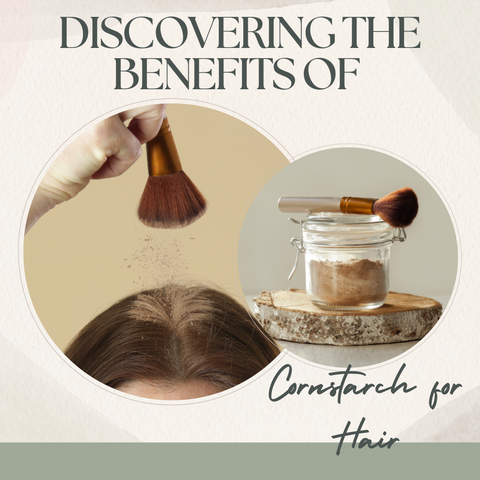
Cornflour, a common kitchen ingredient, has several hair care benefits. It is a natural and adaptable choice for a variety of hair care regimens due to its texturizing and absorbing qualities. Here are some other benefits of using cornflour on your hair, including how it absorbs oil, cleanses your hair gently, adds volume and texture, and relieves inflammation. It adds value to your hair care routine and is great for absorbing oil, adding volume, and soothing the scalp. Trying out cornflour can provide a mild, chemical-free method of keeping hair looking good in between washes.
Cornstarch vs. Traditional Dry Shampoo: What's Better for Your Hair?
Both cornflour and traditional dry shampoos refresh hair between washes, but their formulations and effects on the hair are vastly different. Here's a side-by-side comparison of cornflour and traditional dry shampoo:
Cornstarch:
Pros:
-
Cornflour is a natural pantry staple that is free of harsh chemicals, making it suitable for all hair types and sensitive scalps.
-
It effectively absorbs excess oil from the scalp, giving it a refreshed and cleaner appearance.
-
Due to its gentle nature, it can soothe irritation and may contribute to a healthier scalp.
Cons:
-
Cornflour may leave a visible residue, particularly on darker hair, which requires thorough brushing to blend in.
-
It may not provide the same texturizing or volumizing effects as some styling-specific dry shampoos.
Traditional Dry Shampoo:
Pros:
-
Dry shampoos are specifically designed for hair care, with a wide range of formulations for various hair types, textures, and colours.
-
Some dry shampoos have enhanced texturizing effects, giving hair more volume and manageability.
-
Sprays are frequently available, making application quick and easy.
Cons:
-
Many traditional dry shampoos contain chemicals like aerosols, talc, sulphates, parabens, and other potentially harsh ingredients that may not suit everyone's preferences or sensitive skin.
-
Using traditional dry shampoo regularly can result in product build-up, which can weigh down the hair and scalp.
How Cornstarch Absorbs Oil and Refreshes Hair Naturally
Cornflour can absorb moisture and oils from the scalp and hair because it is a natural absorbent. Its finely powdered texture and molecular makeup are mainly responsible for its absorbing characteristic. To absorb oil and organically revive hair, use this method with cornflour:
-
Absorbent Nature: Cornflour is made up of tiny particles that combine to form a fine powder. These particles have a large surface area, allowing them to easily interact with and absorb excess oils on the scalp and hair strands.
-
Mechanism of Oil Absorption: Cornflour molecules are hydrophilic, which means they attract and bind with water molecules. This property also allows cornflour to bind with excess sebum (natural scalp oils) on the hair and scalp in the case of hair. Cornflour adheres to oils when applied to the hair, effectively absorbing them and reducing the greasy or oily appearance of the hair.
-
Refreshing Hair: Cornflour removes excess oils from the hair, making it appear cleaner and less oily. It aids in the maintenance of a balanced scalp environment by removing excess oil that can cause scalp issues such as itchiness or discomfort.
Because of its tiny particle size and hydrophilic nature, cornflour can easily bond with and absorb excess oils from the scalp and hair, giving it a natural ability to absorb oil and refresh hair. This all-natural option provides a gentle approach to keep hair fresh in between washes without using harsh chemicals, making it a great substitute for commercial dry shampoos.
Utilizing Cornstarch for Different Hair Types and Textures
Cornflour can be used in a variety of ways to treat various hair types and textures. Its oil-absorbing and texturizing properties make it a versatile and natural option in hair care routines. Here's how to use cornflour on various hair types:
-
Fine or Thin Hair: Cornflour can help absorb excess oil from the scalp without weighing down fine or thin hair, giving it a refreshed appearance. It can add volume to fine hair by reducing oiliness at the roots when used sparingly.
-
Oily Hair: Cornstarch's absorbent nature allows it to effectively manage excess oil on the scalp, allowing those with oily hair to go longer between washes.
-
Curly or Thick Hair: Cornflour can help keep the scalp clean without drying out curly or thick hair, which is more prone to dryness at the ends. It can help provide light texture and hold without the heaviness of some styling products.
-
Dark-Colored Hair: Cornflour may leave a white residue on darker hair. Use it sparingly and thoroughly brush it in to blend it in and reduce visibility.
Tips for Different Hair Types and Textures:
-
Start with a small amount of cornflour and adjust as needed to avoid leaving excessive residue or weighing down the hair.
-
Concentrate application on the roots, where oil tends to accumulate more, especially for oily hair types.
-
After applying the cornflour, brush or comb the hair thoroughly to distribute it evenly and reduce visible residue, especially on darker hair.
Cornstarch can benefit various hair types and textures by providing oil absorption, scalp care, and when used strategically, some texturizing effects. Adjusting the application amount and focusing on the specific needs of different hair types ensures that cornstarch can effectively refresh and revitalize hair between washes, offering a natural and gentle alternative to hair care routines.
Creating Your Own Cornstarch Hair Treatments at Home
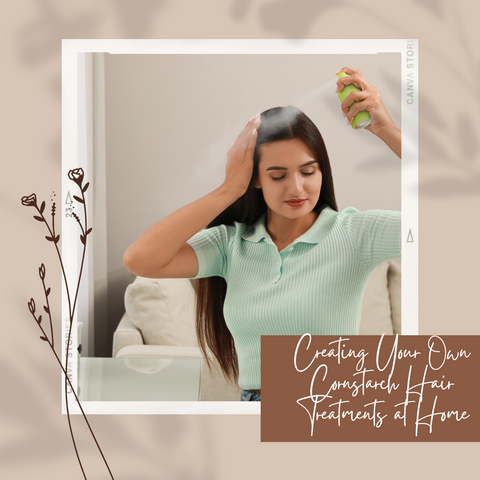
Making homemade cornflour hair treatments can be a cost-effective, natural, and customizable way to care for your hair. Here are a few DIY cornflour hair treatments for various needs:
-
Dry Shampoo Treatment:
-
Ingredients: 2 tablespoons cornflour, 2-3 drops of essential oil (optional for fragrance), and cocoa powder (to make the cornflour blend less visible on dark hair).
-
Instructions: In a mixing bowl, combine cornflour and essential oil. Add a small amount of cocoa powder to match your hair colour and reduce any white residue if you have dark hair. Apply the mixture to the roots or oily areas of the hair with a makeup brush or your fingertips. Massage and brush the scalp to evenly distribute the mixture. Then, use a brush or comb to remove excess powder and blend it in.
2. Scalp Soothing Treatment:
-
Ingredients: 1 tablespoon aloe vera gel, 1 tablespoon cornflour, and 2–3 drops of tea tree oil (which has calming effects).
-
Instructions: In a mixing bowl, combine cornflour, aloe vera gel, and tea tree oil until a smooth paste-like consistency is achieved. Apply the mixture to your scalp and gently massage it in. Rest and rinse after 10-15 minutes to allow the treatment to soothe the scalp. Rinse thoroughly with water, then proceed with your normal shampoo and conditioner routine.
-
Volumizing Hair Treatment:
-
Ingredients: 1 tablespoon each of water, cornflour, and egg white (for volume and protein).
-
Instructions: In a mixing bowl, combine cornflour, water, and egg white to make a paste. Massage the paste into the scalp after applying it to the roots. Leave the treatment on for 15-20 minutes before rinsing. Rinse thoroughly with water before applying shampoo and conditioner.
Tips for DIY Cornstarch Hair Treatments:
- Perform a patch test on a small area of skin to ensure you are not allergic to any of the ingredients.
- Adjust the ingredient amounts based on the length and thickness of your hair.
- To reduce the visibility of dark hair, modify treatments with ingredients such as cocoa powder.
These natural and adaptable DIY cornflour hair treatments provide solutions for dry washing, calming the scalp, and giving your hair more volume. Because they're easy to produce at home, you can customise the ingredients to meet your unique hair needs without worrying about the potentially harsh chemicals present in certain commercial solutions.
DIY Cornstarch Dry Shampoo Recipes for Quick Hair Fixes
DIY cornflour dry shampoo is an effective and natural solution for between-wash hair fixes. Here are a few simple and adaptable recipes for homemade cornstarch-based dry shampoo:
Basic Cornstarch Dry Shampoo:-
Ingredients: 1½ cups cornflour, 2–3 tablespoons ground cinnamon (for red hair), or cocoa powder (for dark hair), and 5–10 drops essential oil (optional, for scent).
-
Instructions: In a mixing bowl, combine the cornflour and cocoa powder or cinnamon. To reduce any white residue, adjust the amount of cocoa powder or cinnamon to match your hair colour. To add fragrance to the dry shampoo mixture, add a few drops of your favourite essential oil. Use a makeup brush to apply the dry shampoo mixture to the roots or oily areas of your hair, or gently sprinkling it onto the scalp. Brush the scalp to distribute the dry shampoo and absorb excess oil. Then, thoroughly brush or comb your hair to remove any visible residue.
Citrus-Scented Dry Shampoo:
-
Ingredients: 2 tablespoons baking soda, 1/4 cup cornflour, and the zest of one or two lemons or oranges.
-
Instructions: In a mixing bowl, combine the cornflour, baking soda, and citrus zest. The zest will give your dry shampoo a refreshing citrus scent. Apply the mixture to the roots or oily areas of your hair, paying special attention to areas where grease accumulates. Massage the scalp to evenly distribute the dry shampoo. Allow it to sit for a few minutes to absorb oils. Brush or comb your hair thoroughly to remove any residue and evenly distribute the dry shampoo.
Herbal Infused Dry Shampoo:
-
Ingredients: 1/4 cup cornstarch, 2 tablespoons arrowroot powder and 2 tablespoons finely ground dried herbs (lavender, rosemary, chamomile, etc.)
-
Instructions: In a bowl, combine the cornflour, arrowroot powder, and finely ground dried herbs to make a herbal-infused dry shampoo. Apply the mixture to the roots or oily areas of your hair with a brush or by gently sprinkling it onto the scalp. Massage the scalp to distribute the dry shampoo and wait a few minutes for the oils to absorb. Brush or comb through your hair thoroughly to remove any visible residue and distribute the dry shampoo evenly.
These homemade dry shampoo recipes made with cornflour provide a quick, easy, and all-natural way to revive your hair in between washes. Customisable, affordable, and devoid of harsh chemicals, they offer a viable substitute for store-bought dry shampoos.
Customizing Cornstarch Mixes for Personal Hair Needs
You can tailor cornflour mixtures to target particular hair issues, such as dryness, oily scalp, dark hair residue, or the need for volume. Customising the components in dry shampoo allows you to develop a product that is specific to your hair type, colour, and preferences while still being natural and efficient for your hair care regimen.
Tips for Applying Cornstarch Effectively in Hair Care
To guarantee correct distribution and absorption, certain strategies must be followed while applying cornflour in your hair care routine, particularly if you are using it as a dry shampoo or for other hair treatments. The following advice will help you use cornflour in your hair care routine:
-
Divide Your Hair Into Sections: Divide your hair into sections, especially if you are targeting specific areas such as the crown or roots. This ensures that the product is applied and covered evenly.
-
Apply Cornflour with a Makeup Brush or Applicator: A clean makeup brush or a powder applicator can help apply cornflour precisely to the scalp's roots or oily areas. It allows for controlled and even distribution.
-
Begin with a small amount of cornflour and gradually increase as needed. Excessive application may result in visible residue.
-
Gently massage the scalp with your fingertips after applying cornflour. This aids in the even distribution of the powder and the absorption of oil.
-
Allow the cornflour to sit on the scalp for a few minutes. This allows it to effectively absorb excess oils.
-
Brush or Comb Using a brush or a wide-toothed comb, distribute the cornflour evenly throughout your hair and remove any visible residue. This step is critical, especially if you have dark hair.
-
If you have darker hair, consider combining cornflour with cocoa powder or another suitable ingredient that matches your hair colour. This helps to reduce the amount of white residue.
-
After applying cornflour, check your hair in natural light or with a handheld mirror to ensure there is no visible white residue.
-
If you are using cornflour as an overnight treatment, apply it before bed so it can work its magic while you sleep. This gives it more time to absorb oil and impurities.
-
Hair care routines differ from person to person. Experiment with the amount of cornflour you use and the frequency with which you use it to find out what works best for your hair type and lifestyle.
By following these guidelines, you can maximise cornstarch's benefits for oil absorption, scalp care, and hair refreshment while minimising visible residue.
Advantages of Choosing Cornstarch Over Chemical Hair Products
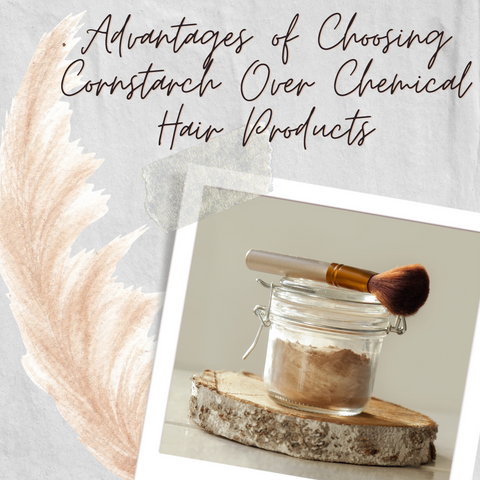
There are several benefits to using cornflour instead of chemical hair products, particularly for people who are searching for gentle, affordable, and natural options to their hair care regimens. The use of cornflour has several benefits, including natural and safe components, health benefits for the scalp and hair, absorption of oil and refreshing properties for the hair, affordability and accessibility, adaptability and versatility, and environmental friendliness. You may attain renewed and healthier-looking hair without using harsh chemicals by adding cornflour to your hair care routine. This helps promote a more sustainable and natural approach to hair care.
Natural and Eco-friendly: Why Cornstarch is a Sustainable Choice
Because of its renewable source, biodegradability, adaptability, and low environmental effect, cornflour is a particularly sustainable option. Relying on hair care products that contain cornflour or incorporating it into routines is a greener way of living that promotes sustainability and environmental consciousness.
Avoiding Product Build-up and Scalp Irritation with Cornstarch
Cornflour can be beneficial in hair care, especially as a dry shampoo or scalp treatment, but certain precautions must be taken to avoid product build-up and potential scalp irritation:
-
Appropriate Application and Distribution: Use cornflour sparingly to avoid over-application and potential build-up. Begin with a small amount and work your way up as needed. To avoid product buildup, concentrate on the roots or oily areas and avoid applying too much product to the lengths of the hair.
-
Thorough Removal: Brush or comb your hair thoroughly after applying cornflour to distribute it evenly and remove any excess powder. This aids in the prevention of visible residue and buildup.
-
Choose Appropriate Quantities: When using cornflour, take into account your hair type and texture. Those with fine hair may require less product than those with thicker hair.
-
Use on Dry Hair: Avoid using cornflour on damp hair because it can create a paste-like consistency that can lead to build-up.
-
Scalp Sensitivity: If you have a sensitive scalp or allergies, test a small area of skin before using it extensively to ensure no adverse reactions occur.
-
Regular Hair Washing: Include regular hair washing in your routine to remove any product, dirt, or oils that have accumulated. This helps to prevent accumulation over time.
-
Alternate with Traditional Shampoos: To maintain scalp health and minimise product build-up, alternate between using cornflour and traditional shampoos.
-
Use Gentle Products: When washing your hair, use gentle, sulfate-free shampoos to effectively remove residue while being gentle on the scalp.
-
Take into Account Hair Colour: If you have darker hair, consider combining cornflour with ingredients such as cocoa powder to reduce visibility and avoid any white residue.
-
Maintain Scalp Health: Keep an eye on the condition of your scalp. If you experience any irritation, redness, or discomfort, stop using the product and consult a dermatologist.
Cost-Effective Hair Care: The Economic Edge of Cornstarch
Cornflour provides a cost-effective advantage in hair care due to its affordability, versatility, and numerous applications. Here's how it helps you save money on your hair care routine:
-
Low Cost: Cornflour is a widely available, low-cost ingredient at grocery stores. Its low cost makes it a more affordable option for hair care than many commercial hair products.
-
Versatility: Cornflour can be used as a texturizer, oil absorber, scalp treatment, and dry shampoo, among other hair care applications. Many hair needs can be satisfied by a single, reasonably priced product.
-
Homemade Remedies: Incorporating cornstarch into DIY hair treatments allows individuals to create cost-effective solutions tailored to their specific hair types and concerns.
-
Dry Shampoo Alternative: Using cornflour as a dry shampoo absorbs excess oil, allowing for longer intervals between hair washes. This reduces the frequency with which traditional shampoos are used and increases their lifespan.
-
Economical Substitute: Cornflour is a natural alternative to commercial dry shampoos and styling products, potentially reducing the need to purchase expensive hair care items.
-
Tailored Solutions: By combining cornflour with other inexpensive natural ingredients, individuals can create personalised hair treatments without the high costs associated with specialised hair care products.
-
Minimal Amount Needed: Cornflour has a high absorption capacity, so it only takes a small amount per application to make a lasting product that offers excellent value for money.
-
Easily Accessible: Cornflour is a convenient and affordable choice for routine hair care because it is readily available in most stores and is easily accessible in most homes.
Because cornflour is inexpensive, adaptable, and has several applications, it provides a cost-effective advantage in hair care regimens. It is an economical option for people trying to manage their hair care needs on a tight budget because of its low cost, many uses, and ability to lessen reliance on more costly commercial hair products.
Embracing a Holistic Approach to Hair Health with Cornstarch
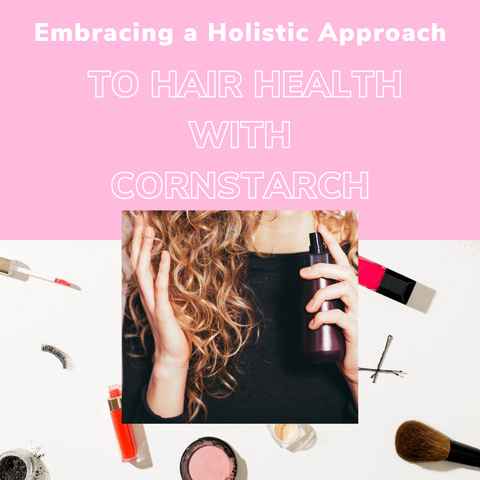
It is necessary to incorporate natural, sustainable, and conscious techniques into your hair care regimen to embrace a holistic approach to hair health using cornflour. You may encourage healthy and vibrant hair from the inside out by utilising cornstarch-based therapies, leading a balanced lifestyle, and giving general well-being some thought.
Enhancing Hair Volume and Texture Using Cornstarch
Cornflour is a simple yet effective natural ingredient for adding volume and texture to hair. Here are some ways to use cornflour for this purpose:
- Volumizing Dry Shampoo:
-
Ingredients: 1 tablespoon baking soda (optional for extra volume), ¼ cup cornflour, and optional essential oil for fragrance.
-
Instructions: Fully combine cornflour and baking soda. If desired, add a few drops of essential oil to create a pleasant scent. Apply the mixture to the roots, concentrating on areas that require volume. Massage gently and set aside for a few minutes. Brush or comb through the powder to distribute it and remove any excess.
2. Texturizing Hair Powder:
-
Ingredients: 2 tsp cocoa powder (for dark hair) or ground cinnamon (for red hair) to match hair colour, ¼ cup cornflour, and a few drops optional essential oil.
-
Instructions: Mix cornflour with cinnamon or cocoa powder. If you would like, add essential oil for fragrance. Add texture to your hair by applying to the roots or all over. Massage gently to distribute the powder. Brush or tousle hair to achieve the desired texture and volume.
3. Dry Powder Styling Aid:
-
Ingredients: 1 tablespoon arrowroot powder (texture enhancer), 1-2 tablespoons bentonite clay (optional for added hold), and a few drops essential oil (optional)
-
Instructions: Combine bentonite clay (if desired), cornflour, and arrowroot powder. If desired, add essential oil for a pleasant scent. Apply sparingly for volume and texture throughout the hair or to the roots. Massage gently and style as desired.
Using cornflour in various DIY hair powder formulations can naturally add volume, texture, and lift to your hair. You can achieve enhanced volume and texture without using commercial styling products by customising mixtures to match your hair colour and adjusting ingredient quantities.
Sensitive Scalp? How Cornstarch Can Be a Gentle Solution
A sensitive scalp may benefit from the mild and calming effects of cornflour. Its all-natural qualities relieve inflammation and absorb extra oil without the use of harsh chemicals. People with sensitive scalps may be able to reduce irritation and gently maintain the health of their scalps by using them in homemade scalp treatments or as a substitute for dry shampoo. For appropriate advice and treatment, see a dermatologist or other healthcare provider if the sensitivity continues or gets worse.
Conclusion: Integrating Cornstarch into Your Everyday Hair Care Routine
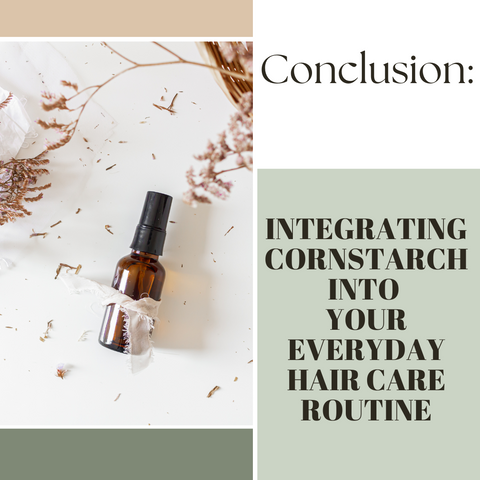
Including cornflour in your regular hair care regimen provides an all-natural, affordable, and adaptable remedy for a range of hair issues. Cornflour can be tailored and used in a variety of ways to support healthier, renewed hair, whether your goals are oil absorption, scalp calming, volume increase, or softer care for a sensitive scalp. For best results, try varied combinations, pay attention to application methods, and customise treatments to meet your specific hair requirements.
































